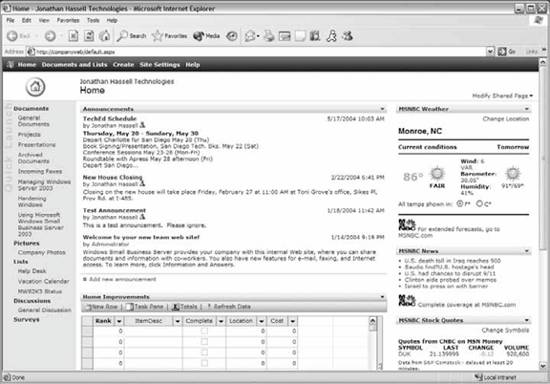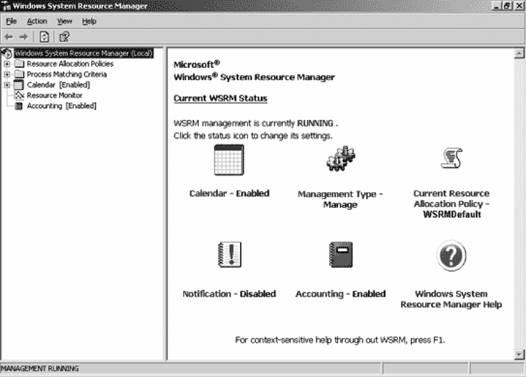13.3. Extending FunctionalityMicrosoft released Windows Server 2003 in April 2003 and Windows Server 2003 R2 in November 2005, and has subsequently been developing extended functionality in the form of feature packs, some of which are free and some of which are available for a fee. Some of these feature packs may be integrated into the core Windows product at a later time, but for the most part you can pick and choose the feature packs you need at this point. This section provides a brief overview of the available feature packs. I'll note which ones ship in the box within Windows Server 2003 R2 within each section. Note that in the body of this book, I have covered a portion of the available feature packs and I've noted that where the discussion of the product is given. The following list includes only feature packs which I haven't discussed already. The other feature packs covered in the book include the following:
http://www.microsoft.com/windowsserver2003/downloads/featurepacks/default.mspx. 13.3.1. Automated Deployment ServicesAutomated Deployment Services (ADS) include a new set of imaging tools and an infrastructure with improved security for rapidly deploying operating systems remotely onto new servers. ADS allows you to quickly install either Windows 2000 Server or Windows Server 2003 on new servers and customize their configuration, much like RIS functions for client computers, as discussed in Chapter 2. ADS also offers a reliable, remote script execution framework that enables administrators to perform script-based administration with security on hundreds of servers as easily as they once did on a single server. However, there are reports that ADS is difficult to use on external drive arrays, which would appear to be a big limitation because external arrays would be an ideal place to store drive images. You can download ADS from: http://www.microsoft.com/windowsserver2003/technologies/management/ads/default.mspx 13.3.2. DSML Services for WindowsDSML Services for Windows (DSFW) allows applications to access Active Directory using the SOAP protocol over standard HTTP, using the Directory Services Markup Language Version 2 specifications. The DSML language is a way for you to represent the structure of your directory and operation performed against it in the form of an XML document. Because DSML is an open format, applications exchanging directory information using it can assure compatibility between themselves. Better still, DSML provides a common ground for specifying directory objects, attributes, and operations. The DSML Services for Windows add-ons allow administrators to let many more applications access Active Directory using methods apart from the common standard, LDAP. Interoperability is the name of the game with DSFW. You can download DSFW from: http://www.microsoft.com/windows2000/server/evaluation/news/bulletins/dsml.asp 13.3.3. Identity Integration Feature PackThe Identity Integration Feature Pack (IIFP) for Windows Server 2003 keeps track of user identities and coordinates user details across Active Directory, ADAM, and Microsoft Exchange 2000 and Exchange Server 2003 implementations. Using the IIFP, you can combine property information for a given user or resource into a single, logical view for easy administration and modification. The IIFP also automates the provisioning of new and updated identity data in the event that you add, change, or delete users. You can use the IIFP with a variety of directory services, including the following:
You can download the IIFP from: 13.3.4. Remote Control Add-on for Active Directory Users and ComputersRemote Control is a small add-on to Active Directory that enables you to right-click a computer account in the Active Directory Users and Computers console and choose Remote Control on that computer. Choosing that option will open a Remote Desktop connection to that computer. Remote Control uses the Remote Desktop Connection software on both the target computer and the computer running the Active Directory Users and Computers console. This add-on works only with Windows 2000 Server, Windows XP Home and Professional, and Windows Server 2003. It does not work with Windows NT or Windows 2000 Professional. You can download this add-on from: This ships on the second CD of Windows Server 2003 R2. 13.3.5. Windows Rights Management Services and ClientMicrosoft Windows Rights Management Services (RMS) for Windows Server 2003 lets users and administrators control access and use of certain documents within the organization. Using RMS-enabled applications, users can specify certain documents as "for eyes only," "not for distribution," and the like to protect sensitive information. RMS requires the purchase of CALs, so it is not a free solution. You can download RMS from: http://www.microsoft.com/windowsserver2003/technologies/rightsmgmt/default.mspx 13.3.6. Microsoft Services for NetWare 5.03aMicrosoft Services for NetWare 5.03a provides a cumulative set of updates and services that have been offered since the release of Services for NetWare 5.01 SP 1. The Services for NetWare (SFN) package offers a bridge between Windows servers and NetWare servers, allowing transitive file access, user and group security, and more. You can download this add-on from: 13.3.7. Windows SharePoint ServicesWindows SharePoint Services (WSS) allows administrators to create portal sites, such as that shown in Figure 13-15, that facilitate information access and worker collaboration. These sites can store documents, calendar information, and presentations, and can pull into a central location information on news and weather as well as on other current events. Figure 13-15. A sample Windows SharePoint Services site
You can download WSS from: http://www.microsoft.com/windowsserver2003/technologies/sharepoint/default.mspx WSS ships on the second CD of Windows Server 2003 R2 and can be installed through Add/Remove Programs once you've installed the R2 components. 13.3.8. Windows Subsystem for Unix ApplicationsThe Microsoft Windows Subsystem for Unix-Based Applications (SUA) , previously known as Windows Services for Unix, now ships included with Windows SererServer 2003 R2. SUA provides a subsystem for programs brought over ("ported") from Unix environment, and serves as an interface between these applications and the Windows NT kernel itself. How does SUA work, at least from a high-level perspective? For example, let's imagine that you have a order tracking and shipping systemone that's critical to your businessthat runs on a Unix machine. While you're trying to integrate your back-end servers entirely to Windows Server 2003, and it's an on-going process, you don't have time to rewrite this application entirely in native Windows code. However, it would be great if you could host this application on a Windows machine for the time being to take advantage of advanced monitoring and management functions as you've seen throughout the book. SUA acts as an interface through which to run your applications. You can compile your application's source code with SUA compiling tools, and install the finished application on computers running Windows operating systems. Here are a few other scenarios in which SUA is likely to be useful for you:
Because the SUA subsystem is layered on top of the Windows kernel, it offers true Unix functionality without any emulation. For Unix junkies, this means that you get case-sensitive file names, job control, compilation tools, and the use of over 300 Unix commands and utilities and shell scripts within Windows itself. A computer running Windows Services for Unix provides two different command-line environments: the Unix environment and the Windows environment. Applications run on specific subsystems and in specific environments. When you load the Interix subsystem, you get a Unix environment; when you run applications on the Windows subsystem, you get a Windows environment. You also get NIS capabilities, which allows directory services over Unix varieties, and password synchronization functionality to map Windows account to Unix identities and vice versa. In addition, the support for NFS allows you to share files and folders using a native Unix protocol. 13.3.9. Windows System Resource ManagerThe Windows System Resource Manager (WSRM) , an add-on feature for the Enterprise and Datacenter editions of Windows Server 2003, provides resource management and enables the allocation of resources, including processor and memory resources, among multiple applications based on business priorities. You can finely tune how resources are allocated to certain tasks to achieve the very best performance possible. Previously, in Windows 2000 Server, this kind of control was available only in the Datacenter Edition of the product, but Microsoft kindly decided to make it available to users running the Enterprise Edition as well. The WSRM is shown in Figure 13-16. Figure 13-16. The WSRM
You can download the WSRM from: http://www.microsoft.com/windowsserver2003/downloads/wsrm.mspx |